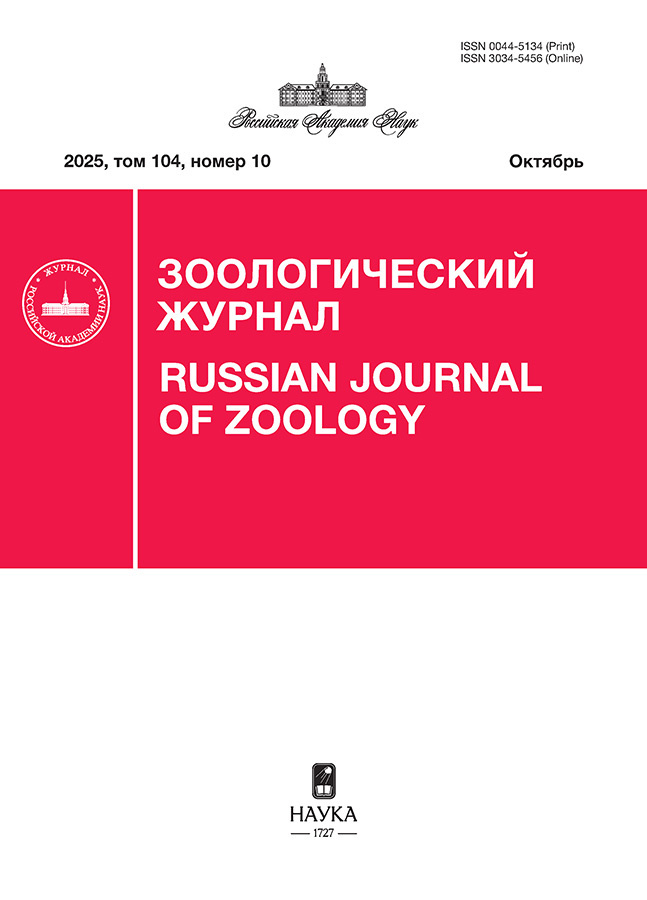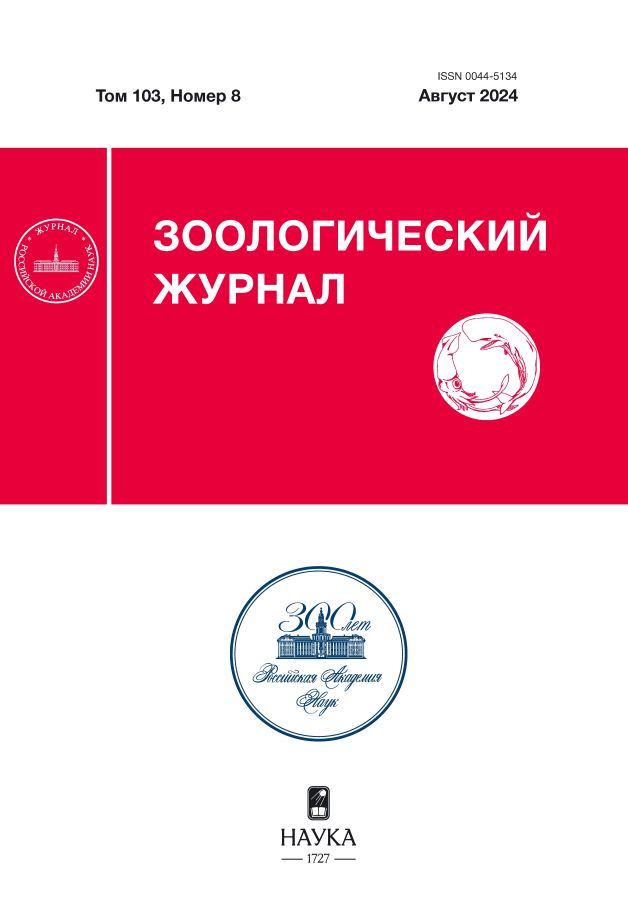Vol 103, No 8 (2024)
ARTICLES
Helminth fauna of auks (Charadriiformes, Alcidae) in the Barents Sea: composition, structure, ways of formation
Abstract
Based both on original and literary data, the results of long-term studies on the helminth fauna of alcids (the Little Auk, Alle alle, the Razorbill, Alca torda, the Atlantic Puffin, Fratercula arctica, the Black Guillemot, Cepphus grylle, the Common Guillemot, Uria aalge, and Brünnich’s Guillemot, U. lomvia, in the Barents Sea region are summarized. 31 species of helminthes (4 trematodes, 11 cestodes, 12 nematodes and 4 acanthocephalans) have been revealed. Some of them circulate in coastal ecosystems, but the realization of life cycles in most species occurs in the pelagial zone with the participation of planktonic invertebrates and fish as intermediate and transport hosts. 24 helminth species of 31 do not reach sexual maturity in alcids and use either other birds or marine mammals as obligate definitive hosts. The structure of the parasitic fauna and the peculiarities of geographic and interspecific distribution of helminthes are related to the evolutionary age of parasite-host systems, host ecology and parasite specificity. A comparative analysis of the helminth faunal composition of alcids in the North Atlantic and Barents Sea shows that Barents Sea birds have a lower diversity of trematodes and cestodes. Differences in the nematode faunal composition are insignificant, whereas records of acanthocephalans are more frequent in the Barents Sea. This seems to be accounted for by different species of parasites having different requirements for environmental conditions and varying degrees of specificity to both intermediate and definitive hosts.
 3-24
3-24


First records of Stigmaeidae (Acari, Prostigmata) from the Dominican Republic
Abstract
First data on the mite family Stigmaeidae (Acari, Prostigmata) of the Dominican Republic are provided. Storchia cuneata Fan et Chen 1997 is recorded and redescribed from the Neotropical Region for the first time. Three species are described as new: Stigmaeus striatus Khaustov et Ermilov sp. n., Eustigmaeus dominicanensis Khaustov et Ermilov sp. n., and E. latisetosus Khaustov et Ermilov sp. n. In addition, some unusual morphological character states of Storchia cuneata are discussed.
 25-44
25-44


 45-50
45-50


Two new spider species (Aranei) from the Cis-Urals Steppe, Russia
Abstract
Based on male material collected from the Cis-Urals steppe, two new species, are diagnosed, described and illustrated: Drassyllus borlynensis sp. n. and Walckenaeria danismani sp. n. A map showing the collecting localities are provided for Walckenaeria danismani sp. n. Drassyllus borlynensis sp. n. differs from the most similar D. praeficus (L. Koch 1866) and D. villicoides (Giltay 1932) in the smaller size, body colouration and the conformation of the male palp. Walckenaeria danismani sp. n. belongs to the subgenus Prosopotheca Simon 1884, where it appears to be most similar to W. baborensis Bosmans 1993, yet differing in the shape of the embolus.
 51-58
51-58


Revision of the Acanthocyclops vernalis-robustus group (cyclopinae, cyclopoida, copepoda) from continental water bodies of the palaearctic with description of a new species
Abstract
A revision of the complex vernalis-robustus group of Acanthocyclops, characterized by 17-segmented antennules and elongated caudal branches, from Palaearctic water bodies is carried out. In total, about 10 taxa of this group have been described from this region, including the invasive American species Acanthocyclops americanus (Marsh, 1892). After this revision, six taxa are recognized as valid, including another species, A. borutzkyi Chaban et Alekseev sp. n. from Sakhalin Island, described here as new. Acanthocyclops magistridussarti Stoch et Bruno, 2011, from groundwaters in Italy, is synonymized with A. orientalis Borutzky, 1966, which also inhabits caves in Primorye of Russia and in South Korea. Acanthocyclops trajani Mirabdullayev et Defaye, 2002 and A. einslei Mirabdullayev et Defaye, 2004, both described from France and Germany, are downgraded to junior synonyms of A. americanus and A. robustus (G. O. Sars, 1863), respectively. Descriptions of all six valid taxa are provided and an identification key is given to all species of this group from Palaearctic water bodies.
 59-78
59-78


Latitudinal temperature characteristics of the arrival, nesting and departure of passerine birds (Passeriformes, Aves) in the North of Western Siberia
Abstract
Temperature indicators of the presence of passerine birds in the near-Ob forested tundra and tundra of Yamal Peninsula are considered, with special reference to latitudinal variability. When moving from the forested tundra to the Arctic tundra, a significant decrease in average arrival temperatures and a temperature decrease at the beginning of oviposition are observed, with no temperature effect revealed on the timing of departure.
 79-86
79-86


The Pancreas Aselli, central fatty inclusion or large mesenteric lymph node of shrews (Soricidae, Eulipotyphla)
Abstract
Pancreas Aselli, large mesenteric gland, central fatty inclusion, fatty or large lymphoid body are some of the names for the large mesenteric lymph node characteristic of shrews. Despite the attention this organ has attracted due to its large size comparable to that of a kidney, it has long remained a mystery to theriologists. Due to the seasonal and age-related variability in weight and size revealed, it has been allotted exclusively metabolic or even storage functions. An analysis of the studies on the large mesenteric lymph node has made it possible to trace the changing views on the roles this organ play in the lymphatic and immune systems of shrews, and to assess the prospects for its further study.
 87-98
87-98


Morphotypic characteristics of the second upper molar (M2) of the brown (Ursus arctos) and polar (Ursus maritimus) bears (carnivora, ursidae)
Abstract
The structure of the second upper molar (M2) of brown (Ursus arctos) and white (U. maritimus) bears was studied, with 9 polymorphic characters identified, and their descriptions given. A west to east geographic pattern was discovered in the variability of the lingual cingulum M2 in continental U. arctos. In island populations of U. arctos, there is likewise a decrease in talon M2 observed from west to east. In general, M2 in brown and polar bears is a rather variable tooth. The brown bear can be reliably differentiated from the polar bear based on the structure of M2 based on 6 characters. Changes in the structure of M2 in U. maritimus is associated with the transition to myophagy. The tooth is reduced, first of all losing its secondary elements and reducing the pressing surface due to the talon. Utsus maritimus has the largest number of progressive features among ancient and modern members of the genus Ursus. In evolutionary terms, the variability of M2 in members of the genus appears to be quite high, reflecting the main phylogenetic directions.
 99-118
99-118


Movements of beluga whales (Delphinapterus leucas, cetacea, monodontidae) off the western coast of Kamchatka peninsula
Abstract
The movements of three mature beluga whales (Delphinapterus leucas) tagged by satellite transmitters off the western coast of Kamchatka Peninsula were analyzed. Before the formation of ice cover, beluga whales remained off the western coast of Kamchatka and in the Shelikhov Bay. As ice was formed and spread, beluga whales used increasingly deeper water areas. The data obtained indicate the possible residence of belugas in the eastern part of the Sea of Okhotsk and prove the genetic isolation of this beluga population from that of the western Sea of Okhotsk.
 119-124
119-124












